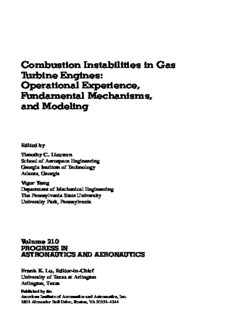Table Of ContentCombustion Instabilities in Gas
Turbine Engines:
Operational Experience,
Fundamental Mechanisms,
and Modeling
Editedby
TimothyC.Lieuwen
SchoolofAerospaceEngineering
GeorgiaInstituteofTechnology
Atlanta,Georgia
VigorYang
DepartmentofMechanicalEngineering
ThePennsylvaniaStateUniversity
UniversityPark,Pennsylvania
Volume 210
PROGRESS IN
ASTRONAUTICS AND AERONAUTICS
FrankK.Lu,Editor-in-Chief
UniversityofTexasatArlington
Arlington,Texas
Publishedbythe
AmericanInstituteofAeronauticsandAstronautics,Inc.
1801AlexanderBellDrive,Reston,VA20191-4344
Copyright(cid:1)C 2005bytheAmericanInstituteofAeronauticsandAstronautics,Inc.Printed
intheUnitedStatesofAmerica.Allrightsreserved.Reproductionortranslationofanypart
ofthisworkbeyondthatpermittedbysubsections107and108oftheU.S.CopyrightLaw
withoutthepermissionofthecopyrightownerisunlawful.Thecodefollowingthisstatement
indicatesthecopyrightowner’sconsentthatcopiesofarticlesinthisvolumemaybemade
forpersonalorinternaluse,onconditionthatthecopierpaytheper-copyfee($2.00)plusthe
per-pagefee($0.50)throughtheCopyrightClearanceCenter,Inc.,222RosewoodDrive,
Danvers, Massachusetts 01923. This consent does not extend to other kinds of copying,
forwhichpermissionrequestsshouldbeaddressedtothepublisher.Usersshouldemploy
thefollowingcodewhenreportingcopyingfromthisvolumetotheCopyrightClearance
Center:
1-56347-669-X/05 $2.50+.50
Dataandinformationappearinginthisbookareforinformationalpurposesonly.AIAAis
notresponsibleforanyinjuryordamageresultingfromuseorreliance,nordoesAIAA
warrantthatuseorreliancewillbefreefromprivatelyownedrights.
ISBN1-56347-669-X
ProgressinAstronauticsandAeronautics
Editor-in-Chief
FrankK.Lu
UniversityofTexasatArlington
EditorialBoard
DavidA.Bearden RichardC.Lind
TheAerospaceCorporation UniversityofFlorida
JohnD.Binder RichardM.Lloyd
viaSolutions RaytheonElectronicsCompany
StevenA.Brandt AhmedK.Noor
U.S.AirForceAcademy NASALangleyResearchCenter
FredR.DeJarnette AlbertC.Piccirillo
NorthCarolinaStateUniversity InstituteforDefenseAnalyses
PhilipD.Hattis BenT.Zinn
CharlesStarkDraperLaboratory GeorgiaInstituteofTechnology
AbdollahKhodadoust PeterH.Zipfel
TheBoeingCompany AirForceResearchLaboratory
Preface
Gasturbineshavemadesubstantialgainsinperformancesincetheirinitialdemon-
strationinjetpoweredaircraftandpowerturbines.Theperformance,noisechar-
acteristics, and pollutant emissions of gas turbines for propulsive applications
continue to improve. On the ground, contemporary gas turbines produce higher
operatingefficienciesandemitfewerpollutantsthanothermajorchemical-energy
conversiondevices.Inaddition,thelowcapitalinvestment,easeofpermitting,and
quickinstallationhavemadethemattractivetoinvestors.Asaresult,gasturbines
have become a dominant technology for new power generating capacity in the
UnitedStatesandworldwide.
Avarietyoffactorshavecontributedtothepopularityofgasturbinetechnology.
Financing considerations are the key high-level driver. Pollutant emissions play
anotherimportantrole,particularlyinmotivatingthespecifictechnologyimprove-
mentsandinnovationsoverthelastdecade.Forexample,intheUnitedStates,the
Clean Air Act Amendments of 1990 imposed strict guidelines on the control of
nitrogenoxides,NOx,which,alongwithSO ,isamajorcontributortoacidrain
2
Thisbookfocusesonaparticularlyseriousdifficultyinlowemissionsgastur-
bines: combustion-driven oscillations. These instabilities routinely constrain the
operatingenvelopeandpoweroutputoffieldedmachinesand,insomecases,leadto
seriousdamageofhotsectioncomponents.Gasturbineusershavefoundthatcom-
ponentssuchascombustorliners,transitionpieces,andfuelnozzlesneedroutine
examinationforpartcrackingorexcessivewearingbecauseofvibration-induced
fretting. At a minimum, this requires downtime for inspections and part repair,
therebyreducingmachineavailability.Attheworst,acrackedpiecemaybeliber-
atedintothehotgaspath,potentiallyrequiringreplacementofexpensiveturbine
components.Inaddition,usersincertaingeographicareashavefoundthatengines
must be seasonally retuned to eliminate oscillations due to ambient temperature
changes.Thecostfortherepairandreplacementofhotsectioncomponents,much
of which is directly attributable to the combustion instability problem, exceeds
$1billionannuallyandconstitutesupto70%ofthenonfuelcostsofF-classgas
turbines.Majorpowergeneratingcompanieshavesufferedlossesinthehundreds
ofmillionsofdollarsbecauseoflostrevenuefromforcedoutages,resultingina
numberoflawsuits.
Althoughinstabilitieshavenotbeennearlyassevereaprobleminnonpremixed
aero engine combustors, they have appeared in a few cases and posed serious
challengesinthedevelopmentstage.Militaryengines,however,haveexperienced
majorproblemswithlow-frequencyinstabilitiesinaugmentors.Alarge-scaleef-
fortiscurrentlyunderwayatseveralgasturbinemanufacturersintheUnitedStates,
incooperationwiththeU.S.AirForce,toovercomesuchdifficulties.
Over the last decade, substantial efforts have been expended in the industrial,
government,andacademiccommunitiestounderstandtheuniqueissuesassociated
withcombustioninstabilitiesinlow-emissionsgasturbines.Theobjectiveofthis
book is to compile these results into a series of chapters that address various
xiii
xiv PREFACE
facets of the problem. In planning this volume, it was decided to include a few
comprehensive chapters, rather than a large number of more narrowly focused
contributions.Assuch,itwasnotpossibletosolicitarticlesfromeverycontributor
tothefield,althoughitiscertainlyourhopethatallrelevantworksareappropriately
representedinthebook.
Following the overview, the book is organized into four basic sections: The
CaseStudiessectioncompileschaptersfromgasturbinemanufacturersandusers
that detail specific experiences with combustion instabilities in the development
stageandinfieldedturbineengines.Thesechaptersdescribethebasicinstability
mitigationapproachesthatweredevelopedandthetradeoffsencounteredbetween
instabilitiesandotherperformancemetrics,suchasNOxemissions.TheFunda-
mental Processes and Mechanisms section addresses the basic phenomenology
ofcombustioninstabilitiesinpremixedandnonpremixedcombustors,themech-
anismsthroughwhichunsteadyheatreleaseprocessesmaybecomeself-excited,
andmeasurementtechniquesforcharacterizingthem.Next,theModelingandDi-
agnosticssectiondescribesanalyticalandcomputationalapproachestomodelthe
complexacousticcharacteristicsofcombustorgeometriesandtheinteractionsbe-
tweenflamesandacousticwaves.Finally,theCombustionInstabilityandControl
sectionaddressesactiveandpassivecontrolofcombustioninstabilities,including
anindustryperspectiveintoapproachesforincorporatinginstabilityconsiderations
intothedesignprocess.
Publication of this volume was made possible through the substantial contri-
butions of a number of individuals. We would like to first thank the authors for
sharingtheirtimeandtalentinpreparingtheirmanuscriptsandcarefullyrevising
them.TheinvaluableassistanceofRodgerWilliams,HeatherBrennan,andJanice
SayloroftheAIAAinthepreparationofthevolumeforpublicationisgratefully
acknowledged. Last, but by no means least, we wish to thank Danning You and
YanxingWangforprovidingthetechnicaldrawingservices.
TimothyC.Lieuwen
VigorYang
July2005
TableofContents
Preface .................................................................. xiii
I. Overview
Chapter1. CombustionInstabilities:BasicConcepts ................. 3
BenT.ZinnandTimothyC.Lieuwen,GeorgiaInstituteofTechnology,
Atlanta,Georgia
Introduction .......................................................... 3
HistoricalOverview ................................................... 5
CausesofInstabilities ................................................. 8
GrowthandSaturationofInstabilities ................................... 16
Conclusion ........................................................... 22
References ........................................................... 24
II. CaseStudies
Chapter2. CombustionInstabilitiesinIndustrialGasTurbines:
SolarTurbines’Experience........................................... 29
KennethO.SmithandJamesBlust,SolarTurbines,Inc.,
SanDiego,California
Introduction .......................................................... 29
LeanPremixedCombustionSystemConfigurationsand
OperatingConditions ................................................ 30
CommercialIntroductionat42ppmvNOx ............................... 33
EmissionsReductionto25ppmvNOx .................................. 35
CombustorPressureOscillationModel .................................. 37
CentaurCPOReduction ............................................... 37
MarsCPOReduction .................................................. 38
RecentExperience .................................................... 40
Conclusion:NeedsandFutureChallenges ............................... 40
References ........................................................... 41
vii
viii
Chapter3. IncorporationofCombustionInstabilityIssuesinto
DesignProcess:GEAeroderivativeandAeroEnginesExperience... 43
H.C.Mongia,T.J.Held,G.C.Hsiao,andR.P.Pandalai,GETransportation,
Cincinnati,Ohio
Introduction .......................................................... 43
FundamentalCausesofCombustionDynamics ........................... 45
ControlStrategies ..................................................... 45
ExamplesofCombustionDynamics ..................................... 46
Combustion–AcousticModeling ........................................ 51
AcousticModelingResults ............................................. 57
Conclusion ........................................................... 61
References ........................................................... 61
Chapter4. CombustionInstabilityandItsPassiveControl:
Rolls-RoyceAeroderivativeEngineExperience ...................... 65
TomasScarinci,Rolls-RoyceCanada,Quebec,Canada
OverviewoftheTrent60Aeroderivative ................................. 66
OscillatoryCombustionintheTrent60DLE ............................. 68
CombustionSystemDesignModifications ............................... 87
Acknowledgments ..................................................... 87
References ........................................................... 88
Chapter5. ThermoacousticDesignToolsandPassiveControl:
SiemensPowerGenerationApproaches .............................. 89
WernerKrebs,SvenBethke,JoachimLepers,PatrickFlohr,andBerndPrade,
Siemens AG, Mu¨lheim, Germany and Cliff Johnson and Stan Sattinger,
SiemensAG,Orlando,Florida
Introduction .......................................................... 89
SiemensGas-TurbineProducts ......................................... 89
PhenomenologicalDescription .......................................... 90
SolutionMethods ..................................................... 93
Application .......................................................... 100
Conclusion ........................................................... 110
References ........................................................... 111
Chapter6. CharacterizationandControlofAeroengineCombustion
Instability:Pratt&WhitneyandNASAExperience ................. 113
JeffreyM.CohenandWilliamProscia,Pratt&Whitney,EastHartford,
ConnecticutandJohnDeLaat,NASAGlennResearchCenter,
Cleveland,Ohio
Introduction .......................................................... 113
EngineCombustionInstability .......................................... 115
EngineAcousticAnalysis .............................................. 116
FuelInjector–AirSwirlerDynamicResponse ............................. 118
SubscaleCombustorExperiment ........................................ 127
ix
Active-ControlDemonstration .......................................... 135
Conclusion ........................................................... 143
Acknowledgments ..................................................... 144
References ........................................................... 144
Chapter7. MonitoringofCombustionInstabilities:
Calpine’sExperience.................................................. 147
JesseB.SewellandPeterA.Sobieski,CalpineTurbineMaintenanceGroup,
Pasadena,Texas
Introduction .......................................................... 147
Combustion-DynamicsMonitoringSystem ............................... 148
GeneralInstabilityCharacteristicsandTuningConsiderations .............. 151
DetrimentalImpactsofCombustionDynamics ........................... 153
CDMforCombustorHealthMonitoring:CaseStudies .................... 154
References ........................................................... 162
Chapter8. MonitoringCombustionInstabilities:E.ON
UK’sExperience ...................................................... 163
CatherineJ.Goy,StuartR.JamesandSuzanneRea,E.ONUK,England,
Nottingham,UnitedKingdom
Introduction .......................................................... 163
WhyMonitorCombustionDynamics? ................................... 163
DescriptionoftheOn-LineCombustion-MonitoringSystem ............... 164
BenefitsofCombustion-DynamicsMonitoring ........................... 165
CaseStudies .......................................................... 166
ImpactofAmbientConditionsonDynamicResponse ..................... 166
ImpactofOperatingRegimeonDynamicResponse ....................... 167
CombustionLinerFailure .............................................. 168
BurnerAssemblyFailure ............................................... 171
Conclusion ........................................................... 175
References ........................................................... 175
III. FundamentalProcessesandMechanisms
Chapter9. CombustionInstabilityMechanismsin
PremixedCombustors ................................................ 179
Se´bastien Ducruix, Thierry Schuller, Daniel Durox, and Se´bastien Candel,
CNRSandEcoleCentraleParis,Chaˆtenay-Malabry,France
Introduction .......................................................... 179
AcousticsforReactingFlows ........................................... 183
HeatReleaseasaPressureSource ....................................... 187
Heat-ReleaseFluctuationsDrivenbyWaves .............................. 197
Conclusion ........................................................... 206
References ........................................................... 207
x
Chapter10. FlowandFlameDynamicsofLeanPremixed
SwirlInjectors ........................................................ 213
YingHuang,ShanwuWang,andVigorYang,PennsylvaniaStateUniversity,
UniversityPark,Pennsylvania
Introduction .......................................................... 213
ColdFlowCharacteristicsofSwirlInjectors .............................. 216
FlameDynamicsofAxial-EntrySwirlInjector ........................... 250
Conclusion ........................................................... 269
Acknowledgments ..................................................... 270
References ........................................................... 270
Chapter11. Acoustic-Vortex-FlameInteractionsinGasTurbines.... 277
SureshMenon,GeorgiaInstituteofTechnology,Atlanta,Georgia
Introduction .......................................................... 277
LengthandTimeScales ................................................ 278
TheoreticalConsiderations ............................................. 280
FactorsAffectingAVFInteractions ...................................... 287
Conclusion ........................................................... 310
Acknowledgments ..................................................... 310
References ........................................................... 310
Chapter12. PhysicsofPremixedCombustion-Acoustic
WaveInteractions..................................................... 315
TimothyC.Lieuwen,GeorgiaInstituteofTechnology,Atlanta,Georgia
Introduction .......................................................... 317
Background .......................................................... 318
Heat-ReleaseResponsetoFlowandMixturePerturbations ................ 323
Conclusion ........................................................... 361
Acknowledgments ..................................................... 362
References ........................................................... 362
IV. ModelingandDiagnostics
Chapter13. AcousticAnalysisofGas-TurbineCombustors........... 369
AnnP.DowlingandSimonR.Stow,UniversityofCambridge,Cambridge,
England,UnitedKingdom
Introduction .......................................................... 369
LinearizedEquationsofMotion ......................................... 371
One-DimensionalDisturbances ......................................... 374
ModalSolutions ...................................................... 389
ApplicationtoGas-TurbineCombustors ................................. 394
ModalCoupling ....................................................... 401
AcousticAbsorbers .................................................... 403
xi
Limit-CyclePrediction ................................................. 406
Conclusion ........................................................... 409
Appendix:DerivationofEq.(13.41) ..................................... 410
References ........................................................... 411
Chapter14. Three-DimensionalLinearStabilityAnalysisofGas
TurbineCombustionDynamics....................................... 415
DanningYou,VigorYang,andXiaofengSun,PennsylvaniaStateUniversity,
UniversityPark,Pennsylvania
Introduction .......................................................... 417
TheoreticalFormulation ............................................... 418
SolutionProcedure .................................................... 433
SampleStudies ....................................................... 433
Conclusion ........................................................... 442
Acknowledgments ..................................................... 442
References ........................................................... 442
Chapter15. ImplementationofInstabilityPredictioninDesign:
ALSTOMApproaches ................................................ 445
ChristianOliverPaschereit,Hermann-Fo¨ttinger-Institute,Berlin
UniversityofTechnology,Berlin,GermanyandBrunoSchuermans,Valter
Bellucci,andPeterFlohr,ALSTOMPowerLtd,Baden,Switzerland
Introduction .......................................................... 445
NetworkRepresentationofThermoacousticSystems ...................... 447
ExperimentalDeterminationofTransferMatricesandSourceTerms ........ 449
ModelingtheBurnerTransferMatrix .................................... 454
Reduced-OrderModelingofComplexThermoacousticSystems ............ 461
ApplicationtoaGas-TurbineCombustor ................................ 475
Conclusion ........................................................... 478
References ........................................................... 479
Chapter16. ExperimentalDiagnosticsofCombustionInstabilities... 481
JongGuenLeeandDomenicA.Santavicca,PennsylvaniaState
University,UniversityPark,Pennsylvania
Introduction .......................................................... 481
PressureMeasurements ................................................ 482
ChemiluminescenceMeasurements ..................................... 485
Infrared-AbsorptionMeasurements ...................................... 500
Laser-InducedFluorescenceMeasurements .............................. 506
LaserMieScattering .................................................. 517
PhaseDopplerParticleAnalysis ........................................ 521
Conclusion ........................................................... 522
Acknowledgments ..................................................... 524
References ........................................................... 524

